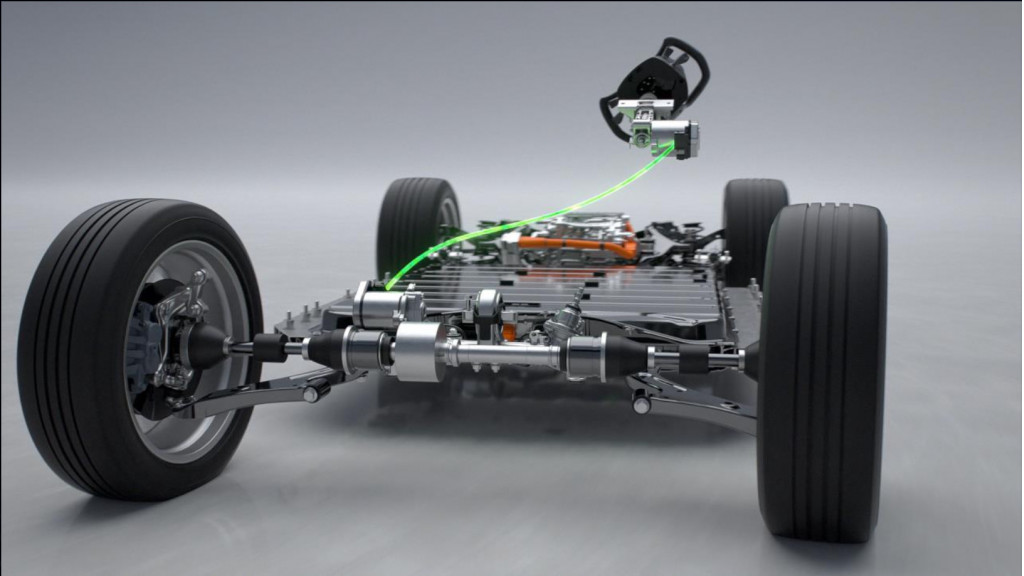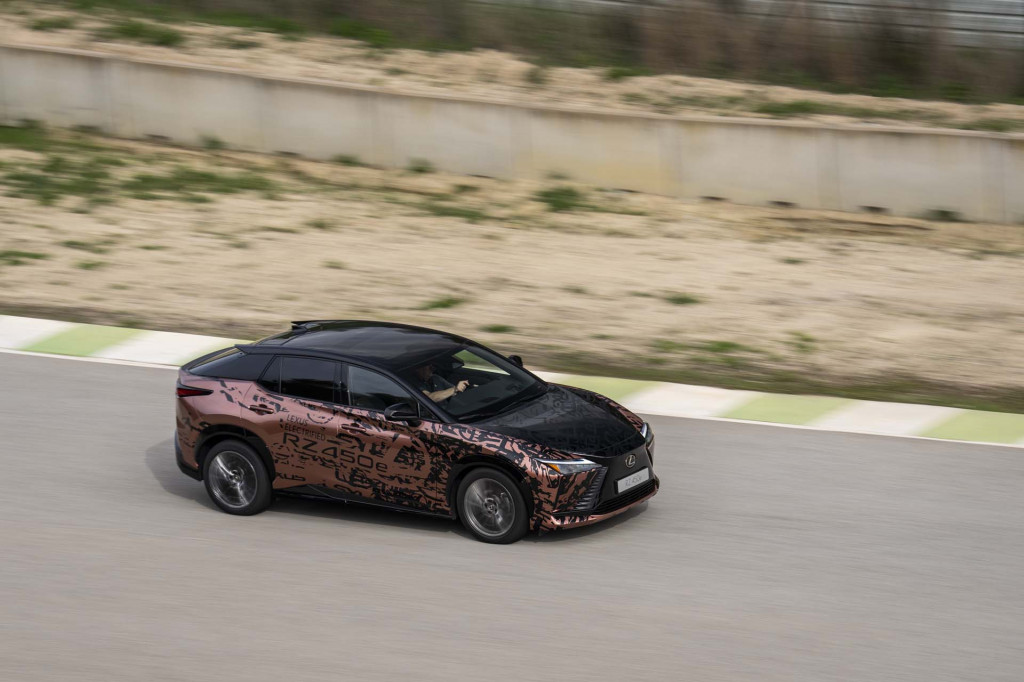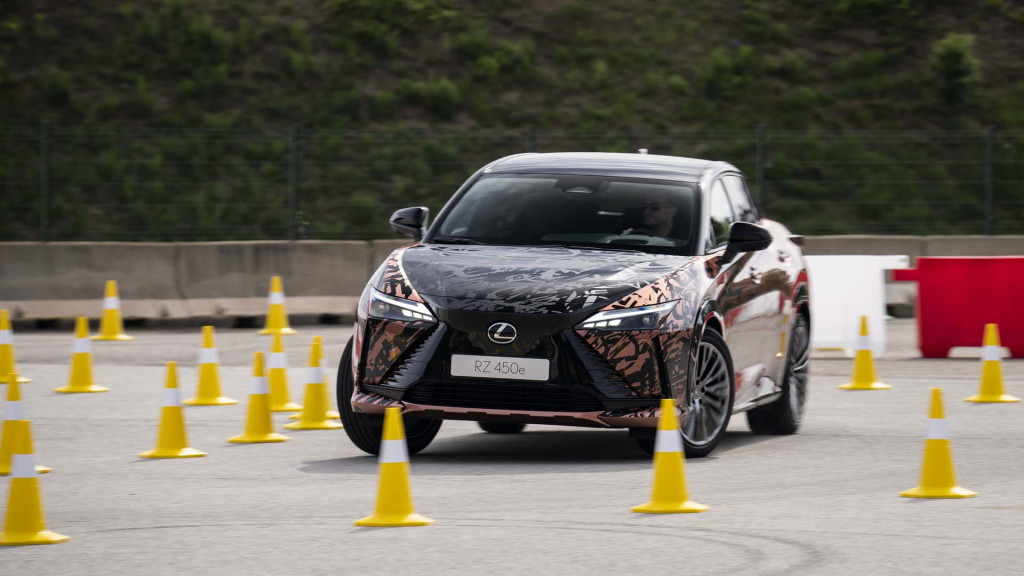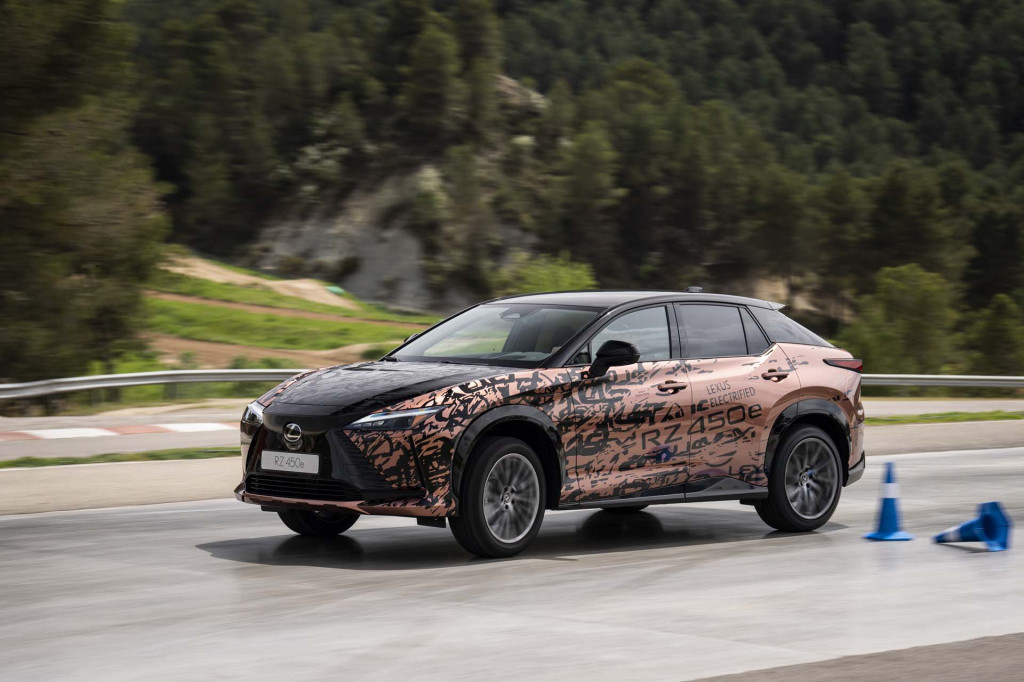After driving the 2023 Lexus RZ 450e prototype with the traditional components, I hopped into the RZ with the yoke and steer-by-wire system. Three turns into my first lap and I thought I might be going nuts. Perhaps it was the European food, lack of sleep, or all the coffee that was keeping me awake, but I felt the tires start to reach their limit of adhesion through the steering wheel. What magic is this?
It seems unnatural and counterintuitive, even unpopular, but Lexus just might be onto something with its yoke and steer-by-wire system. Hear me out.

Lexus steer-by-wire system
How does Lexus’ yoke and steer-by-wire system work?
Lexus created a yoke, but it’s not calling it a yoke. A final term for the topless and flat bottom steering wheel has yet to be determined for the U.S. market. In Europe, it’s called “One Motion Grip,” or OMG for short. Lexus representatives were adamant the OMG name will not carry over to the U.S.. We’ll call it a yoke.
The automaker’s new steer-by-wire system is paired with the yoke. Both are set to debut on the Lexus RZ 450e, but they won’t be available in the first U.S. model year. A timeline for U.S. launch hasn’t been given.
Tesla’s yoke is a terrible, horrible, no good idea because its traditional electric power steering lacks variable ratios, and thus drivers have to steer hand over hand without a top or bottom of the steering wheel to grab. Unlike Tesla’s system, Lexus’ steer-by-wire has no mechanical connection to the wheels, the steering ratio is infinitely variable, and the yoke only requires 150 degrees of rotation lock-to-lock. At higher speeds the system has a slower ratio, and at parking-lot speeds the ratio gets much quicker. To feel linear, the ratio is largely kept steady while cornering or steering inputs are applied. The ratio changes mostly once the yoke is straightened.
Filed under “Americans are going to hate this” category, the yoke requires the driver to basically have two hands on the wheel at the proper 9 o’clock and 3 o’clock placement. Fun fact: That’s the proper way to safely drive a vehicle. Also, thumbs out, not wrapped around the wheel.
The system is designed to provide feedback to the point the driver should know if a wheel weight falls off and the wheel becomes unbalanced.
According to Lexus Chief Engineer Takashi Wantanabe, the system monitors the force on the steering rack based on the torque input from the tires. It does this by measuring lateral and yaw gains. From there, it determines the amount of force feedback that should be sent back to the steering wheel via a torque motor.
The system is fully redundant. With two of everything from can busses and wiring harnesses to programming, it’s fully backed up in case of a failure. The backup system is powered by its own 12-volt battery, so if the main battery dies the system won’t lose steering capability.

2023 Lexus RZ 450e
I kind of liked the yoke
Admittedly, I wanted to dislike the yoke. It seems like a dumb idea. It’s as if someone is trying to reinvent the wheel for no good reason.
But during a racetrack exercise, I found it preferable to a traditional mechanical electric power steering system and steering wheel. The reason is simple: It forces the driver’s hands to be at the proper 9 and 3 grip, or if you want to fudge it a smidge, approaching the less ideal but still acceptable 10 and 2 placement. The variable ratio meant less turning of the wheel and the system just felt natural on the track.
After asking Wantanabe to explain how the system worked, I realized it wasn’t sleep deprivation or the coffee. The steering feel was, seemingly, replicated, to a shocking degree of authenticity on an admittedly smooth and well-kept race track, thanks to the ingenious design.

2023 Lexus RZ 450e
However, at slower speeds like in a parking, the system is a mixed bag as it stands right now.
On what I thought was an autocross with a coned-loop—I was later told it was meant to simulate a parking lot (sorry about that tire chirping and cornering, Lexus)—the steer-by-wire system’s quick ratio was harder to get used to in a short period of time. Still, my judgment never got so out of whack that I hit a cone.
While still linear when turning, the ratio picks up dramatically at slower speeds. I didn’t have enough time behind the wheel to fully get comfortable with the quicker ratio. Moreover, it felt odd to never move my hands from the 9 and 3 positions while navigating a sharp corner as if pulling into a spot at a Costco.
The calibration of the system I tested wasn’t finished. With moderate to heavy throttle at full lock in a corner at (rather brisk, probably unsafe) parking lot speeds, the yoke would twitch as if signals were getting mixed up and the system wasn’t sure what to do. It was repeatable. Lexus Steer-By-Wire Engineer Masayoshi Kobayashi told Motor Authority this was a known issue and the software’s still being tweaked. Admittedly, this particular situation was an extreme example that isn’t likely to pop up except during an emergency maneuver.
Laying ground game for the future
Wantanabe told MA a normal steering wheel could easily be connected to the steer-by-wire system. The yoke represents what cars could be like in the future, but it’s also not about self-driving cars. It’s about disconnecting the steering system from the wheel and freeing up space.
The yoke provides better visibility, a more open and airy feeling around the steering column, and encouragement for drivers to use the proper 9 and 3 hand positions.
Wantanabe noted steer-by-wire enables the steering system to be completely disconnected from what’s going on from the wheels. In the future, if cars were to be autonomous, the system would allow for the steering wheel to stay still while the car is driving itself. Wheels moving freely without hands on them is an awkward thing in Wantanabe’s opinion.
In the near term, Wantanabe floated the idea of drivers using the yoke to play “Gran Turismo” on the infotainment screen when waiting at a charging station. The steer-by-wire system could be electronically connected to the game. The programming could even be matched to the player’s vehicle of choice in the game, and could provide feedback to match the game’s track variables. Lexus hasn’t developed that capability yet, but it could in the future.

2023 Lexus RZ 450e
Added safety and stability
The yoke and steer-by-wire system could also lead to safer cars. In a very brief test on a skid pad to demonstrate how quickly the system can react, I drove the RZ 450e back to back, first with a traditional steering wheel and connected electric-assist power steering, then with the yoke and steer-by-wire.
In the RZ with the traditional setup, the electric powertrain’s instant torque made it easy to get the RZ sideways, and frankly slightly out of control, on the slick skidpad surface.
But it was much harder to break loose and get sideways with the steer-by-wire system. The sensors that detect wheel torque, spin, and suspension movement knew what was going on before sending feedback through the yoke and the system counteracted the slide before it happened to keep the RZ as straight as possible.
Head of Product Planning and Marketing for Lexus Europe Bart Eelen told MA the system can even counteract cross winds. On a bumpy road, the system can remove some of the oscillation so it’s not transmitted to the yoke. Lexus can essentially dial in, or out, whatever it wants the driver to feel and experience.

2023 Lexus RZ 450e
Time and place
The Lexus RZ will be a low-volume model in the U.S. with the automaker only planning an annual production of 4,900 units the first year and 4,800-6,000 units annually thereafter. It will arrive as the automaker’s first electric car sold in the U.S.. It makes sense why the automaker’s launching its steer-by-wire and yoke in the RZ.
The yoke works the way Lexus has implemented it. It and the steer-by-wire system make a lot of sense in a track car or a car meant to be driven spiritedly on winding back country roads. It’s even a good idea for an electric car with the right platform and features to fully take advantage of steer-by-wire’s strengths. The RZ is none of these things, but it previews a steering system that could work well in the future.
Lexus paid for airfare, hotel, and meals so Motor Authority could go drive RZ prototypes to bring you this firsthand report.
